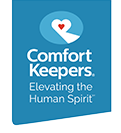Amidst the Coronavirus crisis, during a period of time when staying at home and socially distanced is essential, it’s important to keep seniors safe, reassured, active and cared for.
- One-to-one relationships are important right now. Our caregivers are trained in infection control and senior care, and work in a one-on-one relationship with seniors, reducing the risk of community-wide exposure to COVID-19.
- Seniors are safest at home, away from the risk of infection. Comfort Keepers focuses on care and supportive services centered around serving seniors in their home, where they are best protected.
- Our caregivers can pick up prescriptions, grocery shop or provide transportation to medical appointments.
- Our offices can help with online orders of supplies, meals and other necessities.
- Our caregivers can provide housekeeping and make sure that surfaces are disinfected to keep seniors clean and prepare meals to make sure they are nourished.
 Comfort Keepers is all about Elevating the Human Spirit for clients, caregivers and families. That has never been more important than now. During this time of social distancing, seniors may be socially isolated, in addition to being physically isolated. Comfort Keepers works to help seniors fight depression and loneliness, especially while remaining at home. We help keep them active, optimistic and socially engaged during this period. A daily dose of joy is sorely needed.
Comfort Keepers is all about Elevating the Human Spirit for clients, caregivers and families. That has never been more important than now. During this time of social distancing, seniors may be socially isolated, in addition to being physically isolated. Comfort Keepers works to help seniors fight depression and loneliness, especially while remaining at home. We help keep them active, optimistic and socially engaged during this period. A daily dose of joy is sorely needed.- Supporting families is essential. When a senior is in the care of Comfort Keepers, so is their entire family. We are a supportive resource to address questions, concerns, and check on loved ones.
- Many of our offices provide digital, remote services to extend care (including virtual check-ins). We can enable social connection and augment in-home visits. This includes check-in phone calls.
- Whenever possible and safe, our caregivers are encouraged to practice Interactive Caregiving™. Instead of doing for the client we do with the client. Participating in daily activities will keep seniors active, engaged, and provide a sense of normalcy in a time of uncertainty.
Contact your local office for a free consultation. Let us be a resource during these difficult
times. Learn more at ComfortKeepers.ca.


